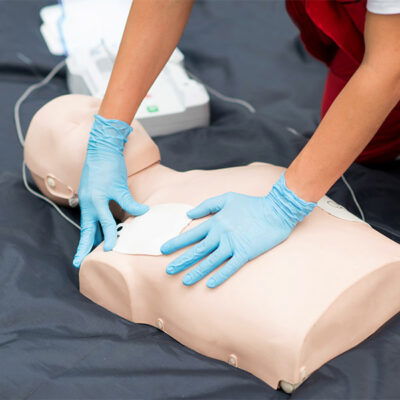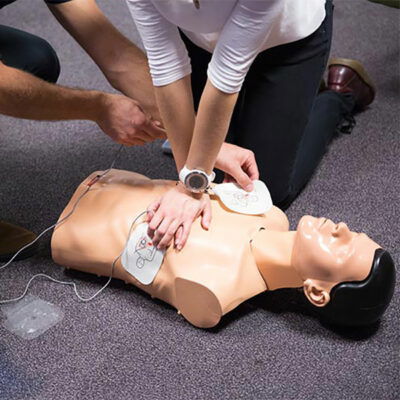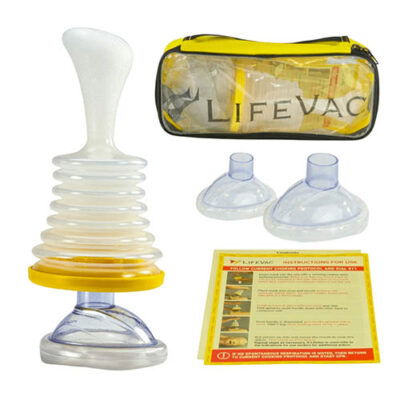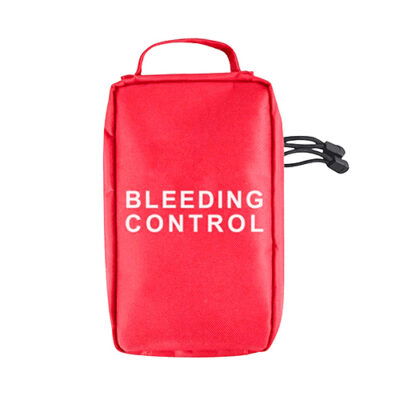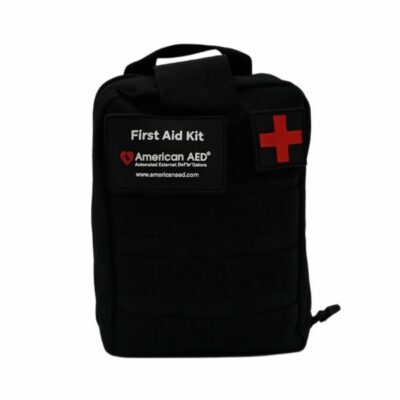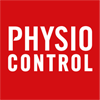The Importance of AEDs Availability in Public Spaces
Police Chief (Ret.) and former Assistant City Manager, Frank G. Fernandez speaks out for more AEDs in schools, law enforcement, and in public spaces.
We often hear about the importance of having an automated external defibrillator (AED) handy, but we’ve never examined this through the scope of law enforcement, often the first to respond to an emergency.
Law enforcement officers handle emergency situations daily, and individuals with firsthand experience in medical emergencies possess valuable insights that are instrumental in scrutinizing and improving emergency management protocols. Their perspectives offer a unique vantage point, enabling them to evaluate the effectiveness of various aspects of emergency response.
Today, we share Chief Fernandez’s thoughts on why AED machines should be used in every school, police vehicle, and space where people gather. We kick off with a purview of his extensive and illustrious career path, share a few of his personal experiences with lifesaving AEDs and emergency safety equipment, and explore how first responder roles are adapting to provide better outcomes in medical emergencies.
Please tell us a little about yourself and provide a bit of background on your Professional Trajectory and Expertise in Safety Solutions.
My background comes from law enforcement primarily. It’s my foundation and where I built my career. I started at the young age of 19 as a public service aide for the City of Miami Police Department. Nine months later I became a police officer and served with the City of Miami Police Department for 25 years. Within those 25 years, the department helped guide me through my formal education. I attended Miami-Dade College, obtained my bachelor’s degree from Barry University, and my master’s degree from Nova Southeastern University.
I had great pride and gratitude to the City of Miami Police for helping me, and as a practitioner I had the opportunity to work in several different units. I was a resource officer. I worked in narcotics as a Sergeant for five years, on a SWAT team for 13 years, both as a team operator and team leader. It was a very volatile, hands-on type of career. Then I held the unique position of being a Lieutenant on a very operational SWAT team at the City of Miami Police Department. I had the opportunity there to travel and become an instructor. I got promoted from Lieutenant, to Commander, and eventually to Deputy Chief. I spent my last seven years at the City of Miami Police Department as Deputy Chief and Chief of Operations. I retired from the City of Miami and went on to the City of Hollywood, where I became the chief of police and the assistant city manager. So, I oversaw the police, the fire department, and code enforcement.
I spent four years there and then was recruited by the City of Coral Gables. I couldn’t turn down the offer to come home to Coral Gables and to spend more time with my family.
I’m still working. Today, I work with the Department of Justice both at the Civil Rights Division and at the COPS, or Community Oriented Policing, office. In the civil litigation section, I’ve investigated police departments across the country Most recently, I got called by the Attorney General of the United States government out of Washington to be part of a school shooting review. As an expert witness, https://blueprints4safety.com I had the distinct opportunity, alongside other experts from around the country, to investigate and conduct a review of that incident.
I can only imagine how difficult it was to conduct those interviews.
It took me to a totally different level with active shooters, and there’s a connection here to AEDs. Think about these active shooters. It’s not if it’s going to happen again, but when it’s going to happen again. Schools need to be properly prepared, not just trained. They must have the right policies. They must exercise that policy, but they also have to have the right emergency equipment in that school. Not just for an unusual unfortunate situation of a person having a heart attack right, or a seizure or a stroke, but if someone does become a victim of these active shooters, and they go into cardiac arrest, that they do have, the automatic external defibrillator and a passive individual who can help. I saw that firsthand — The vital opportunity to really have all the equipment available at the school, including automatic external defibrillators.
"Schools need to be properly prepared, not just trained."
"They must have the right policies. They must exercise that policy, but they also have to have the right emergency equipment in that school."
Did the School have an AED Machine?
I can’t comment on that, but they definitely needed it. You have Sandy Hook Elementary School. You also have several high schools, Parkland here in South Florida, Broward County, that went through this mass casualty situation. This is equipment that a passive individual can operate easily and save lives. I have many examples of how this piece of equipment can really save lives and why I’m such an advocate for it.
Can you share a Pivotal moment when you used an AED that significantly influenced your passion for sharing Lifesaving Knowledge and Tools?
I have several examples. Recently, I was at Miami International Airport. I’m waiting for a flight when people start screaming loudly for help and waving their arms in the air. I ran over, and there was an individual on the ground, bleeding profusely from the mouth. Instinctively, a bystander ran to the AED wall cabinet, grabbed the defibrillator, and brought it over. We placed the AED next to the individual and did a complete assessment, you know, airway, breathing, circulation. We had airway, we had breathing, we had circulation. What he was having was a seizure. He was bleeding from the mouth because he bit his tongue hard. But the AED machine was open, readily available to help although we did not use it. What was inspiring to me is that that person instinctively knew to go and grab it, bring it over, and we opened it up and was readily available.
You know there are victim traumas, but there are witness traumas as well. The person’s daughter was there crying profusely. She was frantic, thinking that her father was going to die, but when she saw the AED there was a sense of relief. Even though it wasn’t necessary, it was readily available and gave her peace of mind. It took first responders over 20 minutes to arrive on the scene after numerous calls to 911. Rescue may have been overly committed to something else, maybe all of the resources were sent out to different emergencies, maybe there were a bunch of different emergencies at the airport that day and they just didn’t have anyone to send. The AED was there to provide that immediate life-saving opportunity and even though we did not use it, it provided psychological relief that it was there in the absence of paramedics.
It’s remarkable to see how law enforcement has embraced the tool. In Coral Gables we had an officer that responded to a local high school where an older individual was running the track and collapsed. First on scene was a Coral Gables Sergeant. He took out his portable AED. The individual was in cardiac arrest, and he brought that person back to life. That same Sergeant was working patrol when a call went out for a local venue where a wedding was being hosted. The father of the bride suffered cardiac arrest. He arrived on scene, took out his AED machine, placed it on the individual, and delivered a lifesaving shock that brought him back to life. They still maintain contact. It was an incredible experience for the family. The father survived because of the AED. Can you imagine what the memory of her wedding would be if her father had passed away? That’s not the case because of an AED.
These examples show you it’s not just saving a life but also the psychological trauma of not having of having a medical tool that’s so easy to deploy and administer.
How would you say Law Enforcement Industry has evolved with AED mandates? What progress has been made on Emergency Safety Equipment over the years and what key factors do you think have driven these changes?
Over the last 10 years, the evolution of police work on the medical side is remarkable. If you look at police officers today on their duty belts, most if not all of them are carrying tourniquets. Most departments today have an inventory of mobile AEDs in their vehicles and first aid kits. Moreover, today, unlike 10 years ago, many police departments are dispatching officers to medical emergencies. They’re typically closer than the rescue unit because they’re already in their patrol zones. For example, where I live, if you call fire rescue, typically the first to arrive is a police officer, and when they knock on your door, they have an AED and first aid kit in hand. That was not seen 10 years ago.
The evolution of medical intervention at the law enforcement level is revolutionary. We have the technology, the ability, and the tools to deploy them for first responding. Here’s the evolution. If a person has a stroke, an officer can render aid, and rescue is able to get them to the hospital within an hour. We know from studies this can reduce vulnerabilities like long-term paralysis.
Coral Gables Fire has done a great job of researching this in terms of stroke victims. Today, we have technology that allows fire rescue units to communicate effortlessly. By the time a patient arrives at the hospital, the hospital already has all the equipment readily available to put that person right into a surgical procedure. Shortened lead times provide an opportunity to reduce the consequences of a stroke or a heart attack.
This also brings a lot of passion and compassion to police work. Sometimes police work is a little bit too cynical because we see so many sad things. When police officers arrive on the scene, there’s usually a negative outcome. We respond to a disturbance, a husband and wife dispute. We calm them down, but I probably embarrass them too by being in their home. Their neighbors are thinking why are the cops at their house? If I stop you and give you a ticket and I tell you have a nice day, you’re going to say have a nice day after you gave me a ticket? There’s usually some negative attribute to our response. So, police officers on the medical side, I really, truly believe that from the psychological level, it provides a little bit of a counterbalance. Now people can see they’re not only law enforcement, they’re also readily available to provide a safety opportunity as a first responder.
"This is equipment that a passive individual can operate easily and save lives."
"I have many examples of how this piece of equipment can really save lives and why I'm such an advocate for it."
Why is it that most of the time Police Officers are first on the scene versus Fire Rescue. Is that just based on like proximity or staffing and how did that transition happen?
Most times the police will be on scene first. Number one, we have more units, and they’re already deployed in a neighborhood. We patrol geographically by zones, and officers assigned to a zone don’t leave that zone. We have saturation, a greater density of patrol vehicles in a particular zone, whereas fire rescuers are deployed from a stationary firehouse. Most fire rescues have incredible response times, but a police officer bridging the gap, being there with the right equipment like an AED can really make a difference not just in survival factors but also in long term consequences.
How would you say that you stay current? Specifically, do you stay current with your CPR and AED skills?
I have been trained, but honestly, I feel like it’s something that I could go back to every six months if not more. Being a reserve officer, I go through annual certifications, so that’s my primary method of getting recertified in all these life-saving techniques and mechanics. There really is no excuse not to have training, even if it’s not formal. You can go on YouTube and educate yourself.
Whoever says they have never been provided training has just never taken the initiative. They need a motivator to go and educate themselves. The motivator should be helping your family, your neighbors, and your community. I think this is vitally important.
Using today’s technology, we can do an enormous amount of education. The American Heart Association provides free learning opportunities. As a matter of fact, in Miami International Airport, there are small kiosks where you can get CPR trained. They’re great when you’re at the airport waiting for a flight. I hate waiting for the flight, so the more distractions I have, the better my flight experience is. If you see a kiosk where you can get some valuable training, go seize the opportunity. The Marlins Stadium has one as well. Have a great time at the ball game and empower yourself to help your family, your neighbors, and your community.
Given your extensive experience in Public Safety, what would you say are some current Trends or Developments that you find particularly interesting or noteworthy?
Now we’re seeing that the first responder, the paramedic side, is being blended in with police officers so they have a joint response. In the past, they worked as silos. Today we have an intersection where they intercept each other, work together, and then go back to their lanes. Also interesting, is the fact that we’re seeing police officers on their belts and in their cars, carrying more medical equipment than ever before. A first aid kit, a stop the bleed kit for mass casualties and traumas. We’re seeing these types of kits on police officers, readily available equipment, the AEDs in police vehicles. I’d like to see more of those. I don’t understand why every year they’re just not acquiring more and more.
If today we’re equipping 50% and we put an additional 10% in the budget every year, we’re increasing our threshold by 10% to get to the eventuality of equipping every vehicle with an automatic external defibrillator.
There really is no reason for a city or government or facility not to have the tools and equipment. I would say that the three tools that are necessary are a first aid kit, a bleeding control kit, and an automatic external defibrillator. Those are the three items that, if you have them readily available, all you have to do at that point is educate your constituents, employees, partners, whomever it may be that you’re working with. This equipment is here for you, your coworkers, clients, citizens, it’s readily available.
What's one lesson your job has taught you about Medical Training and Equipment that you think everyone should learn at some point in their life.
I think the experience that I would take away from my career in law enforcement is know what’s readily available to you, know the equipment when an emergency comes up, be available to render that aid. You don’t want to stand by and be an idle person. You’re going to have regrets. What I don’t want to have, both as a professional or as a citizen in my day-to-day life, I don’t want to have any regrets. I don’t want to think about what I could have done. You have the opportunity to be proactive today.
Do you have any advice or words of wisdom you would like to share with our Community?
The words of wisdom would be what I show my family, what I ask every community member, please try to find an opportunity every day to do an act of random kindness. If we all do a random act of kindness every day, when the opportunity comes up, it’s like vitamin C. It’s positivity coming to you. It’s going to help your heart. Stress has an enormous impact on heart disease, and by doing a random act of kindness every day, you allow your heart to relieve stress for that moment in time. It’s going to give you longevity in your life, but moreover, it’s going to generate that interest in you that when something goes wrong and there’s a medical emergency like I saw at the airport last Thursday, you will respond proactively, affirmatively to help that person in distress.
Thank you very much for allowing me to be part of this incredible opportunity to educate people on automatic external defibrillators and the benefits they have across the board for our police officers, firefighters, and our community.
AED PACKAGES
Related Products
GOT ANY QUESTIONS?
Our experts are here to assist you.





